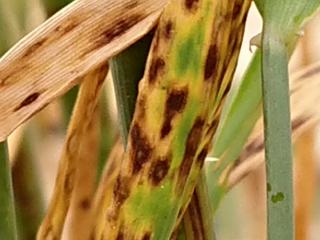Barley growers in higher rainfall parts of Western Australia are asked to keep watch during the 2019 growing season for the newly identified disease ramularia leaf spot (RLS).
The fungal pathogen has been detected in samples taken in 2018 from volunteer regrowth of Oxford barley near South Stirling and from three crops in the South Stirling, Gibson and Munglinup areas.
Department of Primary Industries and Regional Development plant pathologist Kithsiri Jayasena said RLS infection causes leaf spotting and necrosis and could lead to yield loss.
The infection was confirmed late last year following targeted surveys through the Western Region pathology project, which is a Grains Research and Development Corporation investment.
“The development and implementation of molecular identification techniques used in these detections have greatly improved certainty of identification of this disease,” Dr Jayasena said.
Barley is the major host of this disease, however secondary hosts include other cereal crops including wheat and oats and grass species such as perennial ryegrass.
Dr Jayasena said the department would provide more detailed technical information to growers about identification of symptoms and submission of samples through department diagnostic laboratories during the season, however no specific action was recommended at the moment.
“Detection of the disease in crops is unlikely to be possible before flowering in the 2019 season,” he said.
Symptoms of the disease include small brown rectangular lesions within leaf veins that are surrounded by a chlorotic halo. The lesions are visible on both sides of the leaf and generally become evident after flowering.
“Identification of the disease can be difficult as lesions can be confused with other causes such as physiological leaf spotting and boron toxicity or other fungal leaf spotting diseases such as spot type net blotch and spot blotch,” Dr Jayasena said.
Infected seeds are the main source of long distance disease spread and introduction to new areas. More localised disease spread is from airborne spores coming from infected barley and grasses, though this generally requires prolonged periods of leaf wetness.
“The disease is favoured by mild and wetter conditions, such as those that occur along the WA south coast,” Dr Jayasena said.
“Further research into the distribution and potential impact of the disease will be conducted during the coming growing season.
“Foliar fungicides are not currently registered for this disease in Australia, however fungicides registered for management of other diseases in barley, such as net blotches, are known to be effective for ramularia.”
The disease has also been detected in Tasmania.
Media contacts:
Jodie Thomson/Lisa Bertram, media liaison +61 (0)8 9368 3937

